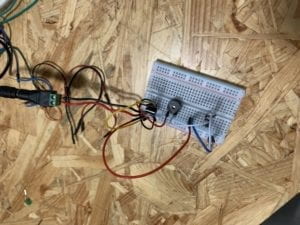In the circuit, the resistor is an electrical component that resists the flow of electricity, in order to control the flow of the current. The LED was used as a form of light source in the circuit, and was an indicator of whether the circuit was working properly or not. The capacitor was used to store the electricity while the current is flowing into them, and was also utilized to release energy. The voltage regulator is a system designed to maintain a constant voltage level. The variable resistor was used to adjust the electrical resistance in the circuit. The switch is used to control the flow of the current in a circuit. The speaker was used to convert the electrical signals given to it into sound signals, and to signify that the circuit was complete.

The process of building the circuit was difficult, as we had to ensure that only the power and ground were connected to the energy, and ensuring the correct wires were placed in the same row as their correct destination. The circuit worked in the end, but it failed when the wires were connected to the wrong row, or when the ground power was not in the row where the energy was. The voltage regulator was not dispensing a constant voltage level to the rest of the board, so to fix the issue, we made sure the voltage regulator was parallel to the breadboard. Our speaker was not functioning, so we replaced it and it then worked.
After reading The Art of Interactive Design, I believe the circuits we built include interactivity in the way that two participants work and influence each other, or how one participant responds to another participant’s input. By designing and creating each part of the circuit, the circuit is then able to respond to our input, and give a signal that it is complete and working. By completing the circuit, it was able to give off a sound as a result of interacting with us pressing the switch.
Interaction design and physical computing can be used to create interactive art, through the process of designing an interactive digital environment and the behind-the-scenes software and hardware to make art that viewers can physically interact with. One installment by Japanese artist Yayoi Kusama, titled “Infinity Mirrored Room – Filled with the Brilliance of Life” features mirrors that brilliantly reflect off of one another, filling the room with constantly changing lights and polka dots that move whenever viewers enter the room or when they look at another corner.